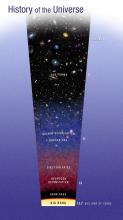Listen to today's episode of StarDate on the web the same day it airs in high-quality streaming audio without any extra ads or announcements. Choose a $8 one-month pass, or listen every day for a year for just $30.
You are here
Serendipity
Arno Penzias and Robert Wilson had a problem. In the 1960s, the researchers at Bell Laboratories were studying radio waves reflected from a giant balloon in orbit. But the signal was noisy. They eliminated every source of interference they could think of — including pigeon droppings inside their radio telescope. But the noise remained.
When they talked to other scientists, though, they realized the “noise” was actually an important discovery: the “afterglow” of the Big Bang.
Astronomy contains many such instances of serendipity — chance discoveries made while working on a different topic.
In 1967, for example, graduate student Jocelyn Bell was using a radio telescope to study quasars — some of the brightest objects in the universe. She discovered several sources, though, that produced regular “pulses” of radio waves. She and her advisor ruled out many possible explanations for these “pulsars.” Another researcher eventually came up with the answer: They’re the spinning corpses of massive stars that “beam” energy into space.
As Bell was making her discovery, satellites were making another. They were looking for nuclear bomb tests, which were banned by a treaty. Instead, they found bursts of gamma rays from deep space. The discovery was declassified in 1973. But it took decades to work out the sources of the gamma-ray bursts: the explosions of massive stars, or the mergers of the corpses of such stars — serendipitous discoveries in the stars.
Script by Damond Benningfield




